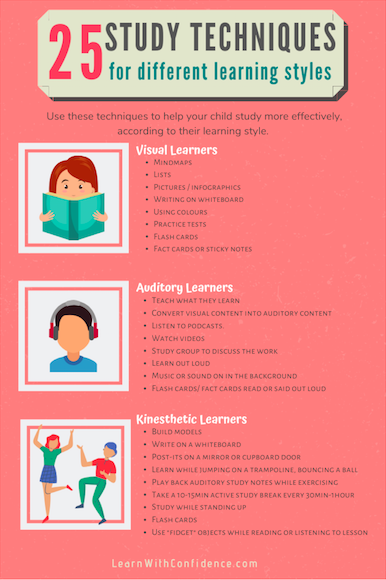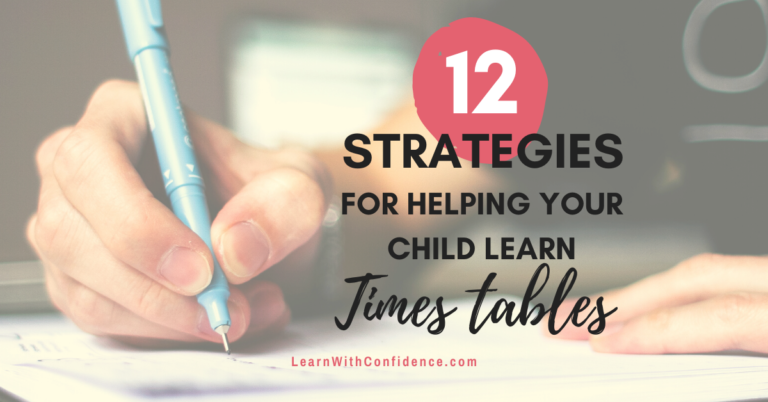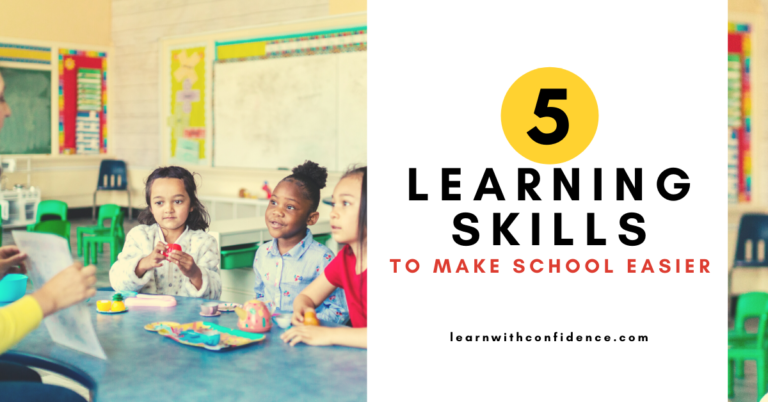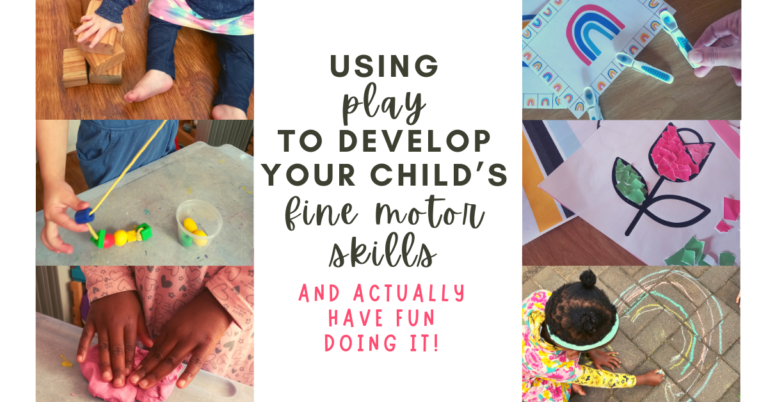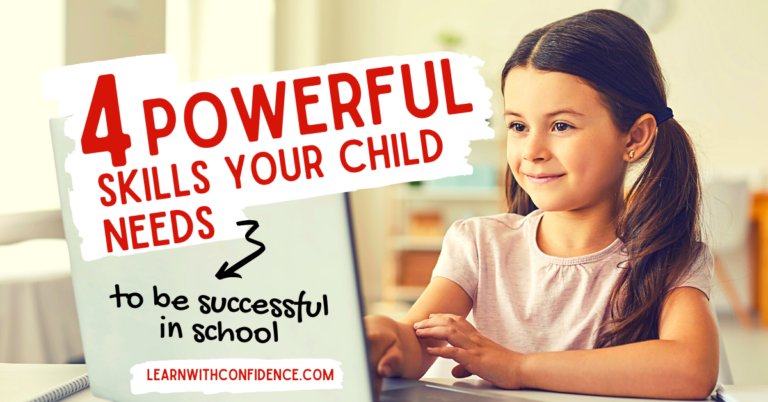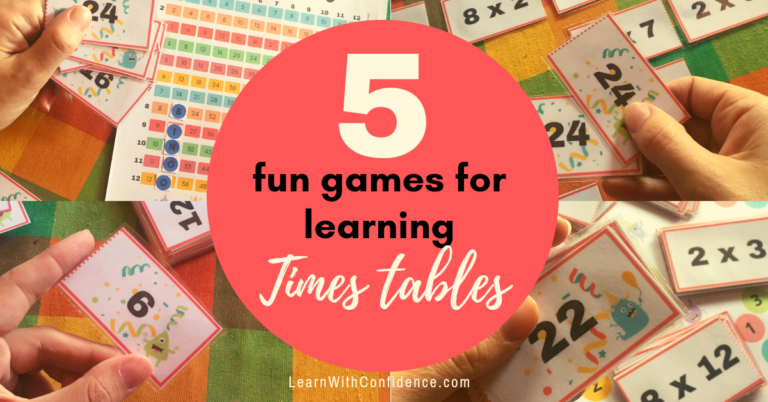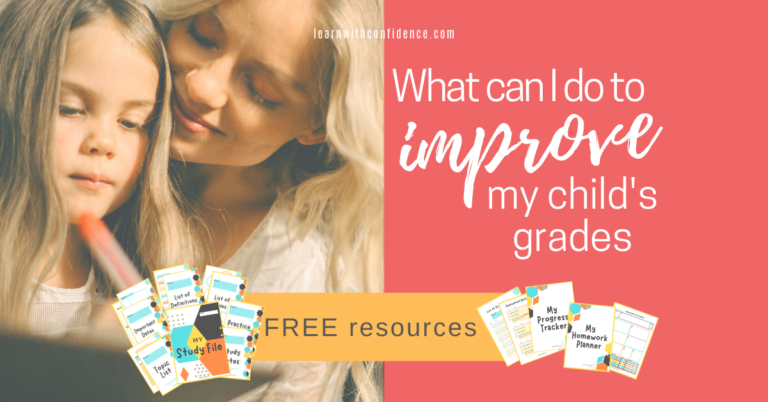Exam Series #3: Beat Exam Stress – Study according to your Learning Style
Every child is unique! Even in the way they learn. Studying should be tailored to each child’s individual way of learning. So, where do you begin!? Here is a bunch of info about how your child learns as well as some very helpful, practical study techniques that are suited to your child’s unique learning style. Let’s get started!
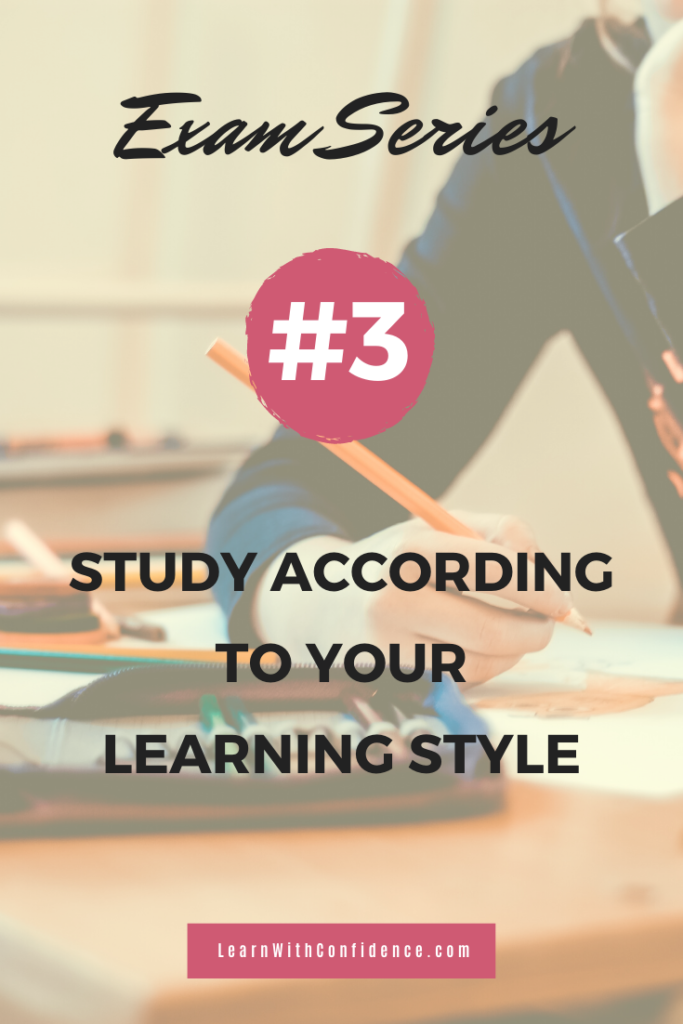
Studying and Learning
Learning is all about how we take in and process information and how we use or apply that information to solve problems or complete tasks. There are three stages: Input, Processing, Output.
Input
This stage is about what goes in and how it goes in. When your child learns in class, does homework at home, studies for tests and exams, they are putting information into their brain. This information includes knowledge of the subject as well as various skills used within the subject.
Processing
Once the information is ‘put into’ into the brain, it must be processed and stored. This is where children make connections between new knowledge and skills and previously learned information. Connections are everything! Once new information is linked to older information, it is processed more effectively and stored more efficiently. If information has been processed and stored correctly, your child will understand their content and be able to remember it well.
Output
Now that the new information has been processed, linked to pre-existing knowledge and stored, now your child must be able to retrieve this info and be able to use and apply it. In tests and exams, you will find three types of questions – 3 ways to use the stored info:
- Knowledge questions – requires remembering and retrieving information
- Understanding – demonstrates that the child made the connections that the information has been processed
- Application – showing that your child can use that information to solve problems, and apply that knowledge to new situations.

Where does studying fit in?
Studying must involve all three stages of learning. Most people only focus on the Input stage, neglecting the Processing and Output stage. But the most effective studying will include all three phases: time spent on acquiring knowledge, time spent on making connections between new and old knowledge, and time spent on practicing to apply that knowledge in different ways.
Below we’ll look at some specific ways you can help your child incorporate all three stages of learning, according to the way they learn best!
Study the way you learn best
Each child is unique. And this means the way they input, process and output information is unique too. If they can learn in a way that is unique to and effective for them, they are more likely to learn more effectively. There are many theories for how different children learn, but I find the concept of learning styles to be quite helpful.
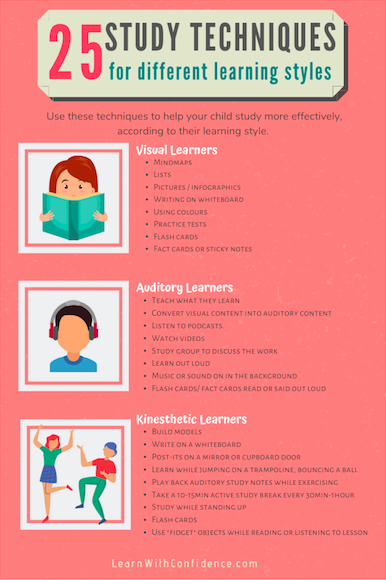
Pressed for time? Download this FREE Printable summarising the Study techniques you can use for each Learning Style.
What is a Learning Style?
A learning style is the method a child uses to acquire and process information. The three main learning styles are visual (seeing), auditory (hearing) and kinesthetic (movement). It is too simplistic to say that every child will fit perfectly into one of these categories. It’s probably more realistic to say that children learn in all of these ways but they have a tendency toward one or two of the learning styles.
Here is a summary of each of the 3 learning styles and how your child can use these to study more effectively!
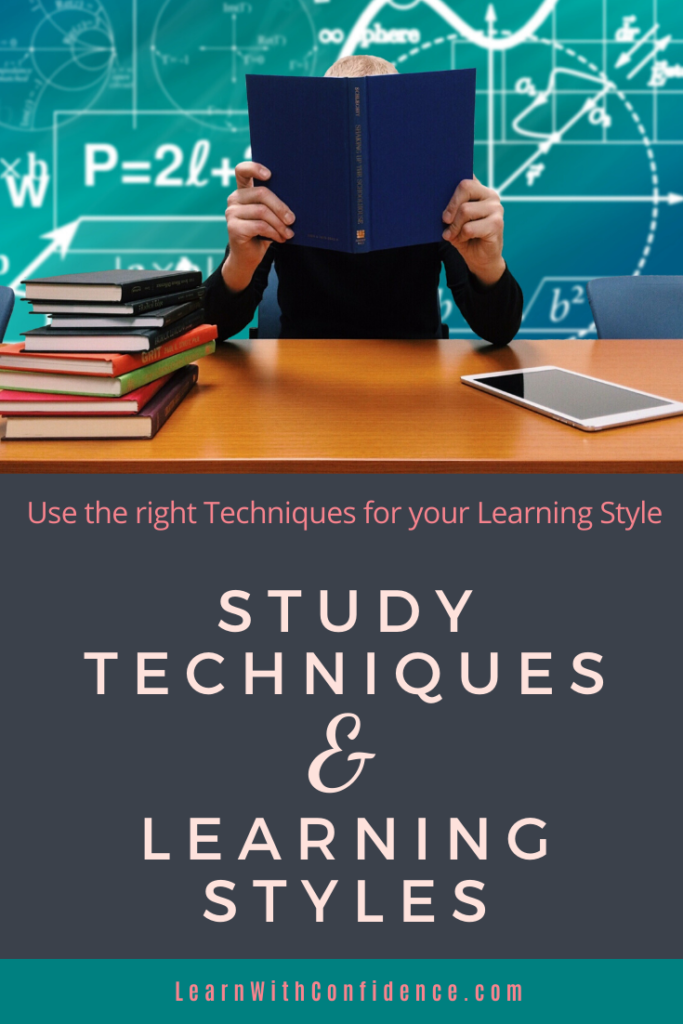
Visual Learning style
The visual learner
A visual learner learns best by seeing. If they can see it, they can learn it, understand it and remember it much better. Visual learners thrive on learning from written notes, diagrams, pictures, graphs or other visual representations of their work. They enjoy and study best when they write notes, draw pictures and using colours when they study.
Much of school is geared toward the visual learner: learning from textbooks, written notes and activities, writing answers in tests, watching videos or powerpoint presentations, following the teacher writing notes and info on the board. Most of the tests and assessments we do are done in a visual way too!
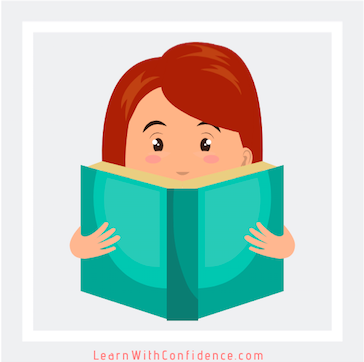
Study techniques for visual learners
Here is a list of study techniques for visual learners so they can study in the way they learn best.
- Mindmaps
- Lists
- Pictures / infographics
- Writing on whiteboard
- Using colours
- Practice tests
- Flash cards (works really well when you put one set of info on one side and the matching info on the other side, eg: timetables, names and properties of shapes, history facts and dates.)
- Fact cards or sticky notes
Auditory Learning style
The Auditory learner
The auditory learner learns best by hearing. These children have an amazing ability to take in and process information by simply listening to the teacher talking. They will remember a lot more of their work if they hear it being taught to them, or if they can discuss it or teach it to others. These children also tend to be the ones that do not enjoy silence, so they love to talk, make or hear sounds or tap on the desk while they’re learning.
Schoolwork and teaching is geared toward these learners too, but not as much as for the visual learner: the teacher explains work or teaches content or skills, videos contain auditory elements, class or group discussions, speeches, dialogues, debates.
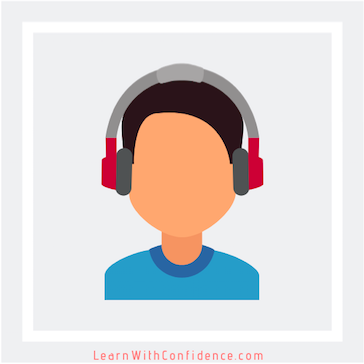
Study techniques for auditory learners
Here is a list of study techniques for auditory learners so they can study in the way they learn best.
- Teach what they learn to someone else / just out loud to themselves
- Turn all of their study content into auditory form – voice recording they can listen to again
- Listen to podcasts, watch videos about the content
- Study group or partner who is also an auditory learner – discuss the work
- Learn out loud
- Music or sound on in the background – be sure to choose the right kind of music
- Flash cards/ fact cards read or said out loud
Kinesthetic Learning style
The kinesthetic learner
The kinesthetic learner learns best by doing. These children can acquire and process information most effectively by engaging with the content on a practical, physical level. They enjoy building things, using manipulatives (physical objects that are teaching/learning tools like counters, blocks, models, etc). They enjoy writing on a whiteboard, being up and moving while they’re learning and any practical activities they do in the classroom.
Unfortunately, school is often not geared towards this learning style. I think there is a move to include more variety in the way we teach, but it’s a mind shift that must take place. Some activities suit children who learn kinesthetically, such as in projects where they have to build a model, creating an artwork, acting out a play, learning-games played in class, any learning activities that take the child outside onto the playground.
Just a side note for older children, writing itself is a kinesthetic activity. Older children who learn best with this method may rely only on writing as part of their learning, but they may find they need to take ‘active’ study breaks to help them stay focussed and engaged.
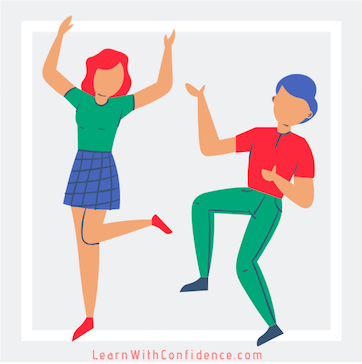
Study techniques for kinesthetic learners
Here is a list of study techniques for kinesthetic learners so they can study in the way they learn best.
- Build models
- Write on a whiteboard
- Write points on post-its or sticky notes and post them up on a mirror or cupboard door
- Learn spelling or times tables while jumping on a trampoline, bouncing a ball
- Record yourself reading your study notes and play them back to yourself while you walk, run, cycle or do gym
- Take a 10-15min active study break every 30min-1hour
- Study while standing up
- Hang a string across the room and peg info cards to it (this works really well for timelines or steps in a process)
- Flash cards
- Some form of “fidget” item for while reading through notes, listening to the teacher, etc.
Developmental Stages and Learning Styles
Just a side note about this: It is important to know what kind of developmental stage your child is in as you help them apply these techniques to their studying. Why is this?
There are many theories about cognitive development. Jean Piaget theorised about concrete and abstract cognition, and that as a child develops, they move from concrete thinking to abstract thinking.
Concrete and Abstract Thinking
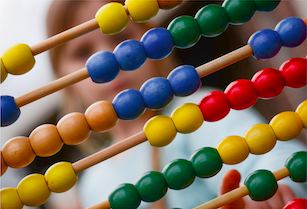
Concrete thinking means that the child must see and experience something to understand it. For example, in the concept of adding, if you put two sweets in her hand and gave her three more, and then asked her how many she now has, she can see that two sweets plus three sweets is a total of five sweets.
A more abstract way of considering this same problem, would be draw a representation of the objects. So the teacher may draw a picture containing 2 sweets and then add another 3 sweets to the picture and then ask the children to work out how many sweets there are altogether.
The most abstract way of considering this problem would be to write the sum and ask the child to calculate it: 2 + 3 = ? = 5
So, what’s the point?
The more concrete your child thinks, the more they will enjoy the kinesthetic learning techniques, so they may appear to be a kinesthetic and visual learner! They will gradually move to more abstract thinking as they grow and develop. Giving them opportunities to use abstract thought is very important.
It’s time to get studying!
Info overload? Don’t worry! Here is a simple infographic you can download, for FREE, to summarise the study techniques you can use for each of the Learning Styles!

